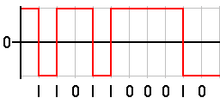Signal edge

In electronics, a signal edge is a transition in a digital signal either from low to high (0 to 1) or from high to low (1 to 0). It is called an "edge" because the square wave which represents a signal has edges at those points.
A rising edge is the transition from low to high.[1] It is also named positive edge. When a circuit is rising edge-triggered, it becomes active when its clock signal goes from low to high, and ignores the high-to-low transition.
A falling edge is the high to low transition.[1] It is also known as the negative edge. When a circuit is falling edge-triggered, it becomes active when the clock signal goes from high to low, and ignores the low-to-high transition.
A leading edge is an event that is triggered on the front edge of a pulse. Assuming a clock begins at t = 0, the first position would be triggered at t = 1.
A trailing edge is the opposite of a leading edge. It is triggered on the back edge of a pulse. Assuming the clock begins at t = 0, the first position would be triggered at t = 0.
The terms front edge or leading edge, and back edge or trailing edge describe the related position of edges in a clock cycle.